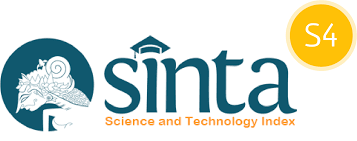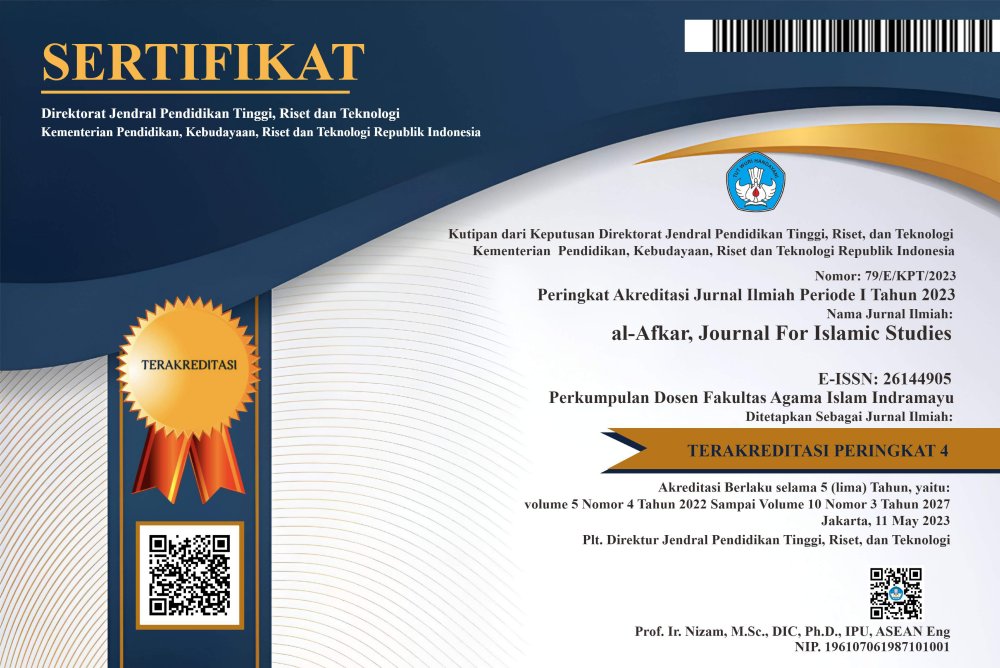Comparative Study of Indonesian Mufassir on how Humans Obtain Hidayah
DOI:
https://doi.org/10.31943/afkarjournal.v7i3.1049Keywords:
Hidayah, mufassir, Comparative InterpretationAbstract
The problem of this research is the assumption among ordinary people that the Hidayah seen in a person is not the same as the guidance referred to in the Qur'an. This is due to the understanding among the people that Hidayah is able to change one's behavior be better, either because of his efforts to obtain guidance or because the Hidayah comes directly from Allah Almighty. This study focuses on how to compare the understanding of the meaning of the whole Hidayah between the mufassirin and Quraish Shihab and aims to know deeply how the understanding of the meaning of hidayah according to mufassirin and find unique concepts offered at the end of this research. To solve this problem, we used the method of library research focused on books and primary and secondary books, plus data analysis and presented it in narrative form. Research like this can be classified in qualitative research. The final result of this research is that in understanding the meaning of hidayah and the techniques to obtain it, we can conclude that at the end of this paper, there are several ways and stages of humans obtaining guidance, according to Quraish Shihab, hidayah obtained through Naluri, Panca Indra, Intellect and Religion gives guidance. As for Hasbi ash Shiddiqi, the model gets guidance through inspiration, five senses and logic. Prof. Muhammad Amin Aziz, said that through the power of human rationality and emotionality, God gave a proposition, Allah sent His Messenger and Book, revelation, inspiration and true dreams.
Downloads
References
Ash Shiddieqi, Teungku Muhammad Hasbi, Tafsir al-Qur’anul Majid an-Nur, Jakarta: Cakrawala Publishing, 2011
Aziz, M. Amin, The Power of al-Fatihah: Meletakkan Dasar-dasar Kebangkitan Peradaban Muslim, Jakarta Timur: Da’i Fiah Qalilah, 2008
Hasan, Abdillah F, Ensiklopedi Lengkap Dunia Islam, Yogyakarta: Mutiara Media, 2011
Shihab, M. Quraish, Tafsir al-Mishbah: Pesan, Kesan, dan Keserasian al-Qur’an, Volume, VII, Jakarta: Lentera Hati, 2002
Tim Penyusun, Ensiklopedi Islam, jilid III, Jakarta: PT Ichtiar Baru van Hoeve, 2005
Zuhaili, Wahbah, Tafsir al-Munir, Volume I, terj. Abdul hayyie al Kattani, dkk, Jakarta: Gema Insani, 2005
Abdoulaye, Bamba, Yahya Fathur Rozy, and Ahmadou Siendou Konate. “MUHAMMAD IBN ABDUL WAHHAB’S PERSPECTIVE ABOUT THE VERSES OF THE QUR’AN REGARDING THE SCIENCE OF THEOLOGY.” QiST: Journal of Quran and Tafseer Studies 3, no. 1 (December 15, 2023): 57–74. https://doi.org/10.23917/qist.v3i1.2913.
Abulmajd, Abdurrahman. “WHAT IS THE MODEL OF MUSLIM RELATIONS WITH THE KAABA FROM THE PERSPECTIVE OF THE QUR’AN.” QiST: Journal of Quran and Tafseer Studies 3, no. 1 (December 16, 2023): 107–45. https://doi.org/10.23917/qist.v3i1.3583.
Adiansyah, Ridho, Adib Sofia, Muin Bensar, Ali Adams, and Mohamed Ahmed Barakat. “ROLAND BARTHES SEMIOTIC STUDY: UNDERSTANDING THE MEANING WORD OF ’AZAB, A REINTERPRETATION FOR MODERN SOCIETY.” QiST: Journal of Quran and Tafseer Studies 2, no. 3 (July 24, 2023): 255–74. https://doi.org/10.23917/qist.v2i3.1445.
Adiansyah, Ridho, and Nurul Faezah binti Yahya. “KHAMR IN THE QUR’AN (THEMATIC STUDY OF TAFSIR IBN JARIR AL-TABARI).” QiST: Journal of Quran and Tafseer Studies 2, no. 1 (November 30, 2022): 1–17. https://doi.org/10.23917/qist.v2i1.1208.
Alhaj, Ali Albashir Mohammed. “Exploring Syntactic and Cultural Problems Faced By Translators in Translating the Quranic Arabic Hope Word L-Amalu لَمَألْا in Surahs Al-Hijr and Al-Kahf Into English.” QiST: Journal of Quran and Tafseer Studies 2, no. 2 (2023): 116–33. https://doi.org/10.23917/qist.v2i2.1679.
AN, Andri Nirwana, Sufian Suri, Sayed Akhyar, Muhammad Amin, Syamsul Hidayat, and Didi Junaedi. “Exploration of Wasatiyah Diction to Realize Sustainable Tolerance Between Religious Communities: A Study of the Translation of the Quran of the Ministry of Religious Affairs of The Republic of Indonesia.” Journal of Law and Sustainable Development 11, no. 12 (December 7, 2023): e2148. https://doi.org/10.55908/sdgs.v11i12.2148.
Anis, Muhammad Yunus, Mangatur Nababan, Riyadi Santosa, and Mohammad Masrukhi. “The Translation of Arabic Speech Act in Syarah Al-Hikam the Works of Muhammad Said Ramadhan Al-Buthi: Analysis of Spiritual Counselling Based on Pragmatic Equivalence.” Journal for the Study of Religions and Ideologies 21, no. 62 (2022): 70–83.
Anurogo, Dito. “Ecofeminism 5.0.” Multicultural Islamic Education Review 1, no. 1 (September 25, 2023): 36–51. https://doi.org/10.23917/mier.v1i1.2828.
Anurogo, Dito, Hardin La Ramba, Nabila Diyana Putri, and Ulfah Mahardika Pramono Putri. “Digital Literacy 5.0 to Enhance Multicultural Education.” Multicultural Islamic Education Review 1, no. 2 (December 8, 2023): 109–79. https://doi.org/10.23917/mier.v1i2.3414.
Anurogo, Dito, Niken Sasadhara Sasmita, Ubed Abdilah Syarif, Nur Rahmah Awaliah, Budhy Munawar Rachman, and Jia Yi Wang Jia Yi Wang (王 家儀). “The Art of Healthy Neurophilocommunication.” Multicultural Islamic Education Review 1, no. 2 (October 4, 2023): 63–82. https://doi.org/10.23917/mier.v1i2.2893.
Arif Wicagsono, Muhammad, Barakat Muhammad Ahmad Muhammad Hamad Al-Nil, and Muthoifin. “Strategies for Improving Teacher Pedagogic Competence Industrial Revolution Era 4.0.” Multicultural Islamic Education Review 1, no. 1 (September 23, 2023): 15–25. https://doi.org/10.23917/mier.v1i1.2816.
Arifin, Zarul, Maisyarah Rahmi Hasan, and Abdurrahman Raden Aji Haqqi. “Qat’I and Zanni Debate From the Perspective of Qur’Anic Studies.” QiST: Journal of Quran and Tafseer Studies 2, no. 1 (2022): 63–67. https://doi.org/10.23917/qist.v2i1.1248.
Armita, Pipin, and Mohd Faizulamri Mohd Saad. “The Concept of Writing in the Qur’an: Analysis of the Terms Kataba, Khat, and Satara.” QiST: Journal of Quran and Tafseer Studies 2, no. 1 (2022): 68–87. https://doi.org/10.23917/qist.v2i1.1339.
Fadli, Nazar. “CONTRIBUTION OF ACEHNESE SCHOLARS TO THE DEVELOPMENT OF QURANIC EXEGESIS IN INDONESIA: A STUDY OF TENGKU MUHAMMAD HASBI ASH-SHIDDIEQY AND HIS WORK ‘TAFSIR AN-NUUR.’” QiST: Journal of Quran and Tafseer Studies 3, no. 1 (December 5, 2023): 1–22. https://doi.org/10.23917/qist.v3i1.3381.
Glynn, Dominic. “Qualitative Research Methods in Translation Theory.” SAGE Open 11, no. 3 (2021). https://doi.org/10.1177/21582440211040795.
Makarim, Muhmmad Ghifari, Hikmawati Rahayu, and Mulia Mardi. “ROLAND BARTHES’ SEMIOTIC ANALYSIS OF THE MEANING OF HARAM IN THE QURAN.” QiST: Journal of Quran and Tafseer Studies 2, no. 3 (September 27, 2023): 331–46. https://doi.org/10.23917/qist.v2i3.2574.
Marthoenis, Marthoenis, Andri Nirwana, and Liza Fathiariani. “Prevalence and Determinants of Posttraumatic Stress in Adolescents Following an Earthquake.” Indian Journal of Psychiatry 61, no. 5 (2019): 526. https://doi.org/10.4103/psychiatry.IndianJPsychiatry_35_19.
Munandar, Siswoyo Aris, and Saifuddin Amin. “Contemporary Interpretation of Religious Moderation in the Qur’an: Thought Analysis Quraish Shihab and Its Relevance in the Indonesian Context.” QiST: Journal of Quran and Tafseer Studies 2, no. 3 (2023): 290–309. https://doi.org/10.23917/qist.v2i3.1448.
Nirwana, Andri, Hayati Hayati, and Muhammad Ridhwan. “The Media of Washatiyah Dakwah in Quranic Exegesis Study.” Budapest International Research and Critics Institute (BIRCI-Journal): Humanities and Social Sciences, 2020. https://doi.org/10.33258/birci.v3i2.919.
Nirwana, Andri, Syamsul Hidayat, Hayati Hayati, Furqan Furqan, Fahmi Arfan, and Susi Fitria. “SOSIALISASI DAN KONSOLIDASI PROGRAM REMAJA MASJID /REMAS TERHADAP TRANSFORMASI AKHLAK REMAJA.” MONSU’ANI TANO Jurnal Pengabdian Masyarakat, 2020. https://doi.org/10.32529/tano.v3i1.480.
Nugroho, Kharis, Muhammad Zawil Kiram, and Didik Andriawan. “THE INFLUENCE OF HERMENEUTICS IN DOUBLE MOVEMENT THEORY (CRITICAL ANALYSIS OF FAZLURRAHMAN’S INTERPRETATION METHODOLOGY).” QiST: Journal of Quran and Tafseer Studies 2, no. 3 (August 21, 2023): 275–89. https://doi.org/10.23917/qist.v2i3.2531.
Nurmansyah, Ihsan, Sherli Kurnia Oktaviana, and Muhammad Adam Abd. Azid. “HUMAN PIG HEART TRANSPLANT: APPLICATION OF ABDULLAH SAEED’S CONTEXTUAL APPROACH TO QS. AL MAIDAH VERSE 3.” QiST: Journal of Quran and Tafseer Studies 2, no. 2 (April 27, 2023): 238–54. https://doi.org/10.23917/qist.v2i2.1469.
Østern, Tone Pernille, Sofia Jusslin, Kristian Nødtvedt Knudsen, Pauliina Maapalo, and Ingrid Bjørkøy. “A Performative Paradigm for Post-Qualitative Inquiry.” Qualitative Research, 2021. https://doi.org/10.1177/14687941211027444.
Parwanto, Wendi, and Engku Ahmad Zaki Engku Alwi. “The Pattern of Sufism on Interpretation of Q.S. Al-Fatihah in the Tafsir Manuscript By M. Basiuni Imran Sambas, West Kalimantan.” QiST: Journal of Quran and Tafseer Studies 2, no. 2 (2023): 163–79. https://doi.org/10.23917/qist.v2i2.1472.
Ravn, Susanne. “Integrating Qualitative Research Methodologies and Phenomenology—Using Dancers’ and Athletes’ Experiences for Phenomenological Analysis.” Phenomenology and the Cognitive Sciences 22, no. 1 (2023): 107–27. https://doi.org/10.1007/s11097-021-09735-0.
Ridha, Ismu, Manshur Mahmud Abu Zinah, Muhibbul Subhi, and M. Nasir. “THE QUR’AN’S STATEMENT ABOUT THE ETIQUETTE OF DEALING WITH THE HOLY QUR’AN FROM SAYYID QUTB’S PERSPECTIVE IN HIS INTERPRETATION OF (ADH-DHILAL): AN ANALYTICAL STUDY.” QiST: Journal of Quran and Tafseer Studies 3, no. 1 (December 13, 2023): 40–56. https://doi.org/10.23917/qist.v3i1.2874.
Rizal Munir, Dede, Maftuhah Maftuhah, Irfan Najmi, Saifuddin Amin, and Muin Bensar. “Singing Methods to Improve College Students’ Arabic Vocabulary.” Multicultural Islamic Education Review 1, no. 1 (September 26, 2023): 52–62. https://doi.org/10.23917/mier.v1i1.2677.
Robiansyah, Dodi, Burhan Lukman Syah, Alip Eko Pasetyo, and Aqila Najiha Mohd Afandi. “Excessive Lifestyle According To Al Munir Tafsir By Wahbah Az Zuhaili.” QiST: Journal of Quran and Tafseer Studies 2, no. 1 (2022): 18–43. https://doi.org/10.23917/qist.v2i1.1278.
Rochmah, Nur Hafifah, and Ahmad Munir. “INTERPRETATION OF THE QURAN WITH A PHILANTROPHIC APPROACH (TAFSIR AT-TANWIR STUDY BY MAJELIS TARJIH DAN TAJDID PP MUHAMMADIYAH).” QiST: Journal of Quran and Tafseer Studies 2, no. 3 (September 5, 2023): 310–30. https://doi.org/10.23917/qist.v2i3.1903.
Rohman, Abdul, Barikli Mubaroka, and Qoree Butlam. “Methodology of Tafseer Al-Qurtubi: Sources, Styles and Manhaj.” QiST: Journal of Quran and Tafseer Studies 2, no. 2 (2023): 180–202. https://doi.org/10.23917/qist.v2i2.1451.
Romadhona, Azizah, Muhamad Subhi Apriantoro, and Laila Muhammad Rasyid. “EXPLORING THE DISTINCTIVE FEATURES OF INDONESIAN TAFSIR AL-QURAN: A STUDY OF SHEIKH ABDUL LATIF SYAKUR’S AD-DA’WAH WA AL-IRSYĀD ILĀ SABĪLI AR-RASYĀD.” QiST: Journal of Quran and Tafseer Studies 3, no. 1 (December 16, 2023): 91–106. https://doi.org/10.23917/qist.v3i1.2912.
Rozy, Yahya Fathur, and Andri Nirwana AN. “PENAFSIRAN ‘LA TAQRABU AL- ZINA’ DALAM QS. AL-ISRA’ AYAT 32 (STUDI KOMPARATIF ANTARA TAFSIR AL-AZHAR KARYA BUYA HAMKA DAN TAFSIR AL-MISHBAH KARYA M. QURAISH SHIHAB).” QiST: Journal of Quran Tafseer Studies 1, no. 1 (2022).
Rozy, Yahya Fathur, Anass Benichou, and Nagoor Gafoordeen. “THE HERMENEUTICS INFLUENCE ON FEMINIST EXEGESIS: A CASE STUDY ON AMINA WADUD.” QiST: Journal of Quran and Tafseer Studies 2, no. 3 (October 7, 2023): 369–81. https://doi.org/10.23917/qist.v2i3.2908.
Rozy, Yahya Fathur, Yohei Matsuyama, and Dina Sijamhodžić-Nadarević. “THE DEVELOPMENT OF QUR’AN COMMENTATORS’ REQUIREMENTS: FROM THE AFFIRMATIVE ERA TO THE REFORMATIVE ERA.” QiST: Journal of Quran and Tafseer Studies 3, no. 1 (December 15, 2023): 75–90. https://doi.org/10.23917/qist.v3i1.2910.
Saiin, Asrizal, and Mohamad Karuok. “The Concept of Sense in the Qur’an: Tazakkur, Nazara, and Tadabbur As the Basic Human Potential Towards a Superior Human Being.” QiST: Journal of Quran and Tafseer Studies 2, no. 1 (2022): 44–62. https://doi.org/10.23917/qist.v2i1.1288.
Saprudin, Udin, J Junaedi, K Kerwanto, and Dito Anurogo. “LIMITING THE NUMBER OF POLYGAMIES TO REALIZE ECONOMIC JUSTICE: A HERMENEUTIC ANALYSIS OF MUHAMMAD SYAHRUR.” QiST: Journal of Quran and Tafseer Studies 2, no. 3 (September 28, 2023): 347–68. https://doi.org/10.23917/qist.v2i3.2769.
Shihab, M. Quraish. Wawasan Al-Qur’an. Bandung: mizan, 1977.
Shihab, M.Quraish. Tafsir Al-Miṣbāḥ, Pesan, Kesan Al-Quran, Keserasian Jilid I. Jakarta: Lentera Hati, 2002.
Sule, Muhammad Maga. “RESPONSE TO MUSLIMS DA’WAH ACTIVITIES’ BY NON-MUSLIMS IN AKWANGA AND NASSARAWA EGGON LOCAL GOVERNMENT AREAS OF NASARAWA STATE, NIGERIA.” QiST: Journal of Quran and Tafseer Studies 3, no. 1 (December 5, 2023): 23–39. https://doi.org/10.23917/qist.v3i1.3110.
Sutrisno, Andri, M. Rama Haqiqi, Baiq Melisa Roza, and Muhammad Masruri Dalail. “Qur’Anic Insights on Religious Moderation and Its Relevance To Religious Harmony in Indonesia.” QiST: Journal of Quran and Tafseer Studies 2, no. 1 (2023): 102–15. https://doi.org/10.23917/qist.v2i1.1470.
Syihab, M. Quraish. Pesan, Kesan Dan Keserasian Al-Qur’an. Vol 1. Jakarta: Lentera Hati, 2007.
———. Tafsir Al-Misbah Jilid 8. Jakarta: Lentera Hati, 2007.
Tobroni, Tobroni, Eka Firmansyah, Rajindra Rajindra, and Nazar Fadli. “Spirituality as a Paradigm of Peace Education.” Multicultural Islamic Education Review 1, no. 1 (September 23, 2023): 26–35. https://doi.org/10.23917/mier.v1i1.2813.
Wahid, Abd., Mazlan Ibrahim, Bukhori Abdul Shomad, Andri Nirwana AN, and Damanhuri Damanhuri. “UTILIZING ZUHD HADITHS FOR UPPER-CLASS CRIME PREVENTION.” Jurnal Ilmiah Islam Futura 23, no. 2 (August 4, 2023): 263–82. https://doi.org/10.22373/jiif.v23i2.17353.
Wiranto, Erham Budi, Suranto, Muhammad Maga Sule, and Nagoor Gafoordeen. “The Baseline of Multicultural Education: An Examination from Islamic and Buddhist Standpoints.” Multicultural Islamic Education Review 1, no. 2 (December 8, 2023): 96–108. https://doi.org/10.23917/mier.v1i2.2895.
Yahya, Abdullah Muhammad, Moh Abdul Kholiq Hasan, and Andri Nirwana AN. “Rights Protection Guarantee for the Partners of Indonesian Gojek Company According to Labour Laws No 13 of 2033 and Maqasid.” Al-Manahij: Jurnal Kajian Hukum Islam 16, no. 1 (May 30, 2022): 115–32. https://doi.org/10.24090/mnh.v16i1.6382.
Downloads
Published
How to Cite
Issue
Section
License
Copyright (c) 2024 Muhammad Hanif Alimi, Fahmi Dolles Marshal, Andri Nirwana. AN

This work is licensed under a Creative Commons Attribution 4.0 International License.



















